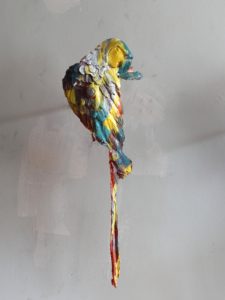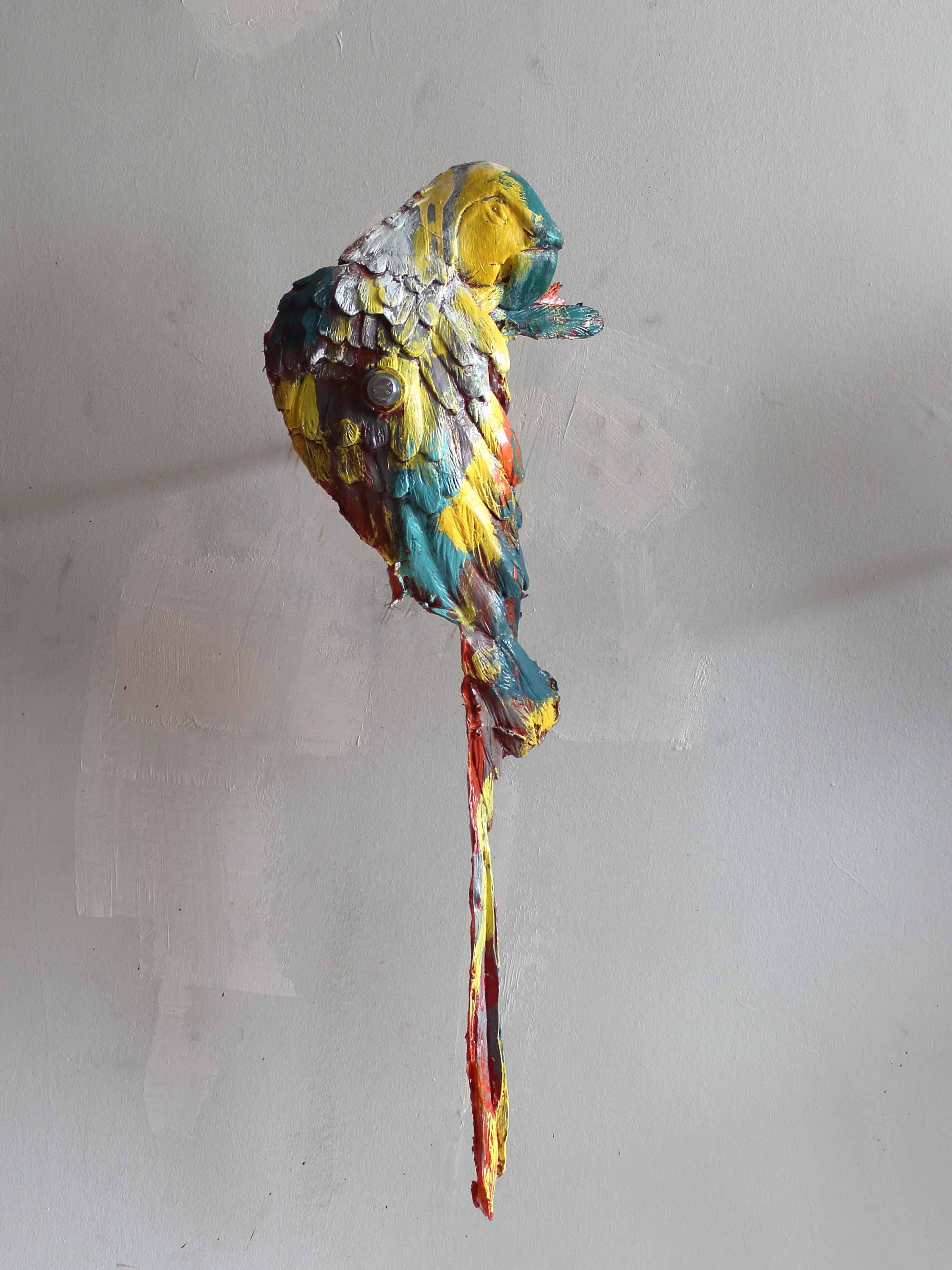Feb 17 was a chilly Sunday night in Red Hook but there was a hot party at the Peninsula Art Space at 352 Van Brunt: the opening of a show called Viel Feind, Viel Ehr.
Passing through the folks who had spilled out on the sidewalk to smoke and chat, I found my way into the gallery where Red Hook’s hippest were drinking cans of Budweiser from a massive cooler as the display lighting illuminated works from German and American artists, brought together for what its literature calls, “the first iteration of a collaborative project between Peninsula Gallery and the Berlin project space nationalmuseum.”
The show is co-curated by Johnny Mullen and Raaf van der Sman. Johnny Mullen, bearded and casual, is as affable as he is erudite, and has been curating in Brooklyn and other points NYC for decades.
He told me about the “other opening” in Berlin, in October, sort of a sister project with this one, with some of the same artists. “The general idea,” he says, “is in the tradition of a sort of non-existent band called S.Y.P.H. and the Dusseldorf punk record label, Pure Freude.” (It’s worth going to peninsulaartspace.com to get started reading about S.Y.P.H. — just FYI.) “So we have American artists having their first show in Berlin. And then replicating that experience the other way around, with German artists having their first show in The States.”
 The name of the show, Viel Feind, Viel Ehr, translates most directly (I think) as “many enemies, much honor.” In it I hear, “the more danger, the more honor,” or “the greater the danger, the greater the honor [in victory].” True enough. It echoes the more pedestrian Americanism, “with great risk comes great reward,” but with the added feature of facing not just hardship, but outright hostility to one’s undertaking. In this case, I’m assuming the undertaking is art. And while I can’t imagine the art in this show engendering many enemies, it does court risk. It is rather amazing.
The name of the show, Viel Feind, Viel Ehr, translates most directly (I think) as “many enemies, much honor.” In it I hear, “the more danger, the more honor,” or “the greater the danger, the greater the honor [in victory].” True enough. It echoes the more pedestrian Americanism, “with great risk comes great reward,” but with the added feature of facing not just hardship, but outright hostility to one’s undertaking. In this case, I’m assuming the undertaking is art. And while I can’t imagine the art in this show engendering many enemies, it does court risk. It is rather amazing.
And not just amazing but presented in an amazing way. You’ll have to visit the gallery to see for yourself just exactly how, but I can say that one feature of its effect is that these works, by many different artists, are all unlabeled. I’d have to peek at the price list if I wanted to know titles and artists’ names and, not wanting to cheat myself out of the experience, I found myself left, without the typical clues, to ponder the connection(s) between the varied works of photography, sculpture, painting, video, pencil drawing, and other media.
“Labels get in the way aesthetically,” Mullen says. “You can respond much more purely when they’re not there. It’s a more pure and immediate visual experience without them.” This was the experience I had when I got there before I’d even had this chat.
The first piece I really spent time with seemed to be a close-up photograph of an exposed frame of film. A successful photo of a failed photo? Until I availed myself of the price list & discovered that the piece (photo print on aluminum, by Marike Schuurman), was titled, “Self-portrait of a Photo Booth 07.”
I was fascinated by a video installation that featured close-up moving images of slot machine gambling and pharmacological testing. I let it loop around to the beginning. It began with a long sequence of leaves quivering in the wind before a wall of graffiti and a spray-painted title sequence, followed by bright Nikes in action on a treadmill. The piece is suggestive of the sometimes rough, sometimes loving collision between humans and machines, between the organic and the fabricated (and with plenty of mannequins to drive home the point). The artist is Andreas Bunte, and the piece is called “Laboratory Life.”
“I curate a lot of video,” said Mr. Mullen. “And, sadly, it’s true that with much of it, people watch it for a few frames and then just check out, but with Andreas’ work…” His voice trails off and he waves a casual hand at the flatscreen on the wall behind him. He needn’t say more. I watched the whole thing twice, myself.
The work I responded to most viscerally was perhaps the simplest: an orange, plastic, injection-molded seat–such as one might see in an elementary classroom, its legs removed, and the back folded forward almost touching the seat (having been softened with heat?), leaving it not quite any longer a chair, and not yet quite anything else, except possibly cartoon duck mouth, leaping to explain itself from its (again, unlabeled) place on a bare, white, gallery wall. The piece is called Seat, and it’s by Hester Orlemans.
I was quite sure that Jeroen Jacobs’ Untitled, a bent (melted?) baking tray in a cylinder of clear PVC, was by the same person who did Seat, both bent items, both presented so simply. I was delightfully wrong.
Peninsula Gallery has been in its spot for about five years now, with Johnny Mullen having recently named its director by owner Eric Fallon, who himself opened Peninsula in 2013 after Hurricane Sandy flooded Red Hook and the neighborhood was, in Eric’s words, “forced to come together to collaborate, persevere and rebuild.”
Viel Feind, Viel Ehr runs through May 4. Hours are Saturday and Sunday 12-7 or by appointment, so go check it out. And when you get there, remember to look up. You’ll see, as I did at the show’s opening, two bright parrots (of latex on polyurethane resin and epoxy with steel hardware), one purplish and one lemonish, overseeing the gallery from their perches near the ceiling. They’re by Jerry Blackman.
Author
Discover more from Red Hook Star-Revue
Subscribe to get the latest posts sent to your email.










